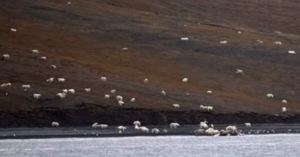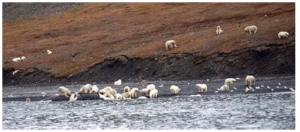During a visit to the remote polar region, tourists aboard the vessel Akademik Shokalskiy were astonished to spot what they initially thought was a flock of white sheep grazing along the water’s edge on Wrangel Island, situated in the Arctic Ocean under Russian control.
However, their excitement turned to awe when they realized that the white animals were not sheep at all, but rather a gathering of over two hundred polar bears drawn to the shoreline by the presence of a whale carcass.

This extraordinary sight unfolded on September 19, with the polar bears lingering in the area for a day or two as they feasted on the whale carcass.
Capt. Rodney Russ of Heritage Expeditions described the encounter as an unforgettable experience, remarking on the diversity of polar bears of all ages, sizes, and sexes congregated around the whale.
The Siberian Times later reported on the event, estimating that up to two hundred thirty polar bears were present, a staggering sight that surprised some tourists who initially mistook the bears for grazing sheep.

Wrangel Island, a nature reserve spanning nearly three thousand acres of pristine Arctic land, boasts the highest density of polar bear dens globally. Each winter, around four hundred mother polar bears raise their young on the island.
This incident underscores the profound impact of human activity on animal behavior. The bowhead whale’s demise, likely the result of commercial whaling operations in the area, provided a bountiful food source for the polar bears. It serves as a poignant reminder of the importance of safeguarding our environment and its inhabitants. Through efforts to mitigate climate change, preserve wildlife habitats, and enforce regulations on commercial activities, we can work towards ensuring the rarity of such events in the future.





